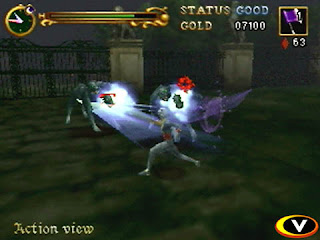Before today's current generation of games, the music of many video games were just composed of sound effects and was usually very repetitive. The soundtracks of early games were not very deep enough that it could connect the player to the game. When Castlevania appeared onto the world of gaming, one of the many things the series was praised for was its' musical score. the most popular songs of the series are "Vampire Killer", "Bloody Tears", and "Bloodlines." These songs have appeared in many other games of the series including modern titles such as Castlevania: Dawn of Sorrow. The consistent use of these same soundtracks (revamped to keep up with the times) has shown a deep interest and connection with the music. The music has even influenced the modern culture of today's music as well. Video Games Live performed a song that was a mash up of various soundtracks in the series in their performance tour. the rap artists known as Army of The Pharaohs used musical bits from "Bloody Tears" to their own song, also called "Bloody Tears." Lily Allen, a songwriter/singer added soud effects and music from the first Castlevania game in her "Cherly Tweed" which she released in her debut album. The music of Castlevania has influenced the minds of many artists on global scale. If there is one thing Castlevania will always be known for, it will be for its music.
http://en.wikipedia.org/wiki/Castlevania
Monday, February 28, 2011
Thursday, February 24, 2011
The 3D step
When the Nintendo 64 and Sony Playstation came out, a new era of games emereged. These systems had to power to display 3D graphical games, far superior to the previous generation concoles which could only display 2D as the limit. The Kobe branch under Konami believed it was possible for Castlevania, normally a 2D side scroller, could work in 3D. Production of the game began in summer 1997 and eventually saw became playable once the Tokyo Game Show of October 1998. The fans were impressed with what they were able to play. The Castlevania 64 was set to release in the U.S. on January 26, 1999. When released, two characters were dropped from the game (which would later be released on the expanson pack version later that year along with improved graphics and enemies). The game received solid ratings and popular reception, showing Castlevania was possible in 3D. When the time line was released in 2002, the Nintendo 64 Castlevania games were removed from it because they were only considered side projects of the creators. Today, these games have been criticized as being the worst of the series, but I beg to differ. It gave gamers the chance to see some of their favorite monsters come to life on 3D, revealed what could be added to enhance the overall experience, and demonstrated that Castlevania can keep up the current generation of consoles.
because of this..
http://en.wikipedia.org/wiki/Castlevania_(Nintendo_64_video_game)
Monday, February 21, 2011
The origins of Castlevania
The idea to create Castlevania was inspired from early monster movies that came out in the early 20th century. The story of the game is loosely based upon the novel Dracula, written by Bram Stoker. Borrowing many of his weaknesses from the book (cross, bible, holy water specifically), his main weakness was a whip know as the Vampire Killer. The only people who could wield this whip were the Belmonts or those who are related to them by blood. The series first appeared as Akumajō Dracula on the Family Computer Disk System in Japan in 1986 produced by the Konami game company. It gained attention when the game was released as Castlevania in the U.S. in 1987. These audiences embraced the game with high remarks.This highly remarked reception encourged Konami to establish Castlevania as a well known franchise.
http://castlevania.wikia.com/wiki/Castlevania_(video_game)
http://castlevania.wikia.com/wiki/Castlevania_(video_game)
Subscribe to:
Comments (Atom)


